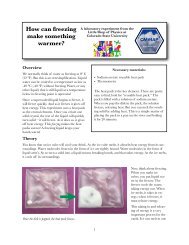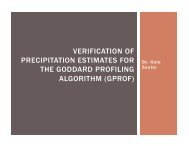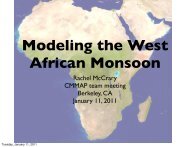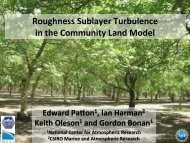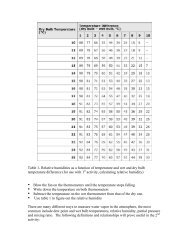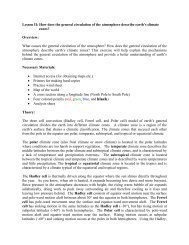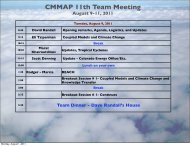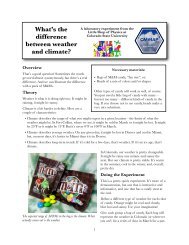Convection-Resolving Forecasting with the WRF Model - cmmap
Convection-Resolving Forecasting with the WRF Model - cmmap
Convection-Resolving Forecasting with the WRF Model - cmmap
You also want an ePaper? Increase the reach of your titles
YUMPU automatically turns print PDFs into web optimized ePapers that Google loves.
<strong>Convection</strong>-<strong>Resolving</strong><br />
<strong>Forecasting</strong> <strong>with</strong> <strong>the</strong><br />
<strong>WRF</strong> <strong>Model</strong><br />
Joseph B. Klemp<br />
National Center for Atmospheric Research<br />
Boulder, Colorado<br />
36 h Reflectivity<br />
Forecast<br />
4 km <strong>WRF</strong> <strong>Model</strong><br />
Radar<br />
Reflectivity<br />
10 June 2003 12Z
Challenges in High-Resolution NWP<br />
Physics<br />
“No Man’s Land”<br />
• Small-scale observations<br />
• Data assimilation<br />
• <strong>Model</strong> resolution/numerics<br />
• <strong>Model</strong> physics<br />
• Predictability<br />
• Ensemble forecasting<br />
• Forecast verification<br />
1 10 100 km<br />
Resolved <strong>Convection</strong><br />
Cumulus Parameterization<br />
3-D Radiation<br />
LES<br />
Initial State<br />
Uncertainty<br />
Two Stream Radiation<br />
PBL Parameterization<br />
Mean<br />
Truth<br />
t critical<br />
Deterministic<br />
Forecast<br />
Probabilistic<br />
Forecast
Advanced Research <strong>WRF</strong> Core<br />
• Nonhydrostatic, compressible flux-form equations<br />
• Terrain-following hydrostatic pressure vertical coordinate<br />
• Arakawa C-grid, two-way interacting moving nested grids<br />
• 3 rd order Runge-Kutta split-explicit time differencing<br />
• Conserves mass, momentum, dry entropy, and scalars<br />
using flux form prognostic equations<br />
• 5 th order upwind or 6 th order centered differencing<br />
for advection<br />
• Multiple physics combinations (many converted from MM5)
Physics Options Implemented in <strong>WRF</strong><br />
– Microphysics: Kessler-type (no-ice),Reisner,<br />
Lin et al. (graupel included),<br />
WSM3, WSM5, WSM6, Ferrier<br />
– Cumulus <strong>Convection</strong>: New Kain-Fritsch, Grell Ensemble,<br />
Betts-Miller-Janjic<br />
– Shortwave Radiation: Dudhia (MM5), Goddard, GFDL, CAM*<br />
– Longwave Radiation: RRTM, GFDL, CAM*<br />
– Turbulence: Prognostic TKE,<br />
Smagorinsky, constant diffusion<br />
– PBL: MRF, MYJ, YSU<br />
– Surface Layer: Similarity <strong>the</strong>ory, MYJ<br />
– Land-Surface: 5-layer soil model, RUC LSM<br />
Noah unified LSM, CLM*<br />
* In progress
<strong>WRF</strong> <strong>Model</strong> Testing and Verification<br />
PBL LES, Δx = 50 m<br />
Density current, Δx = 100 m<br />
5 min 10 min 15 min<br />
(Chin-Hoh Moeng)<br />
Supercell thunderstorm,<br />
Δx = 1 km<br />
Mountain wave,<br />
Δx = 20 km<br />
Baroclinic wave,<br />
Δx = 100 km
<strong>WRF</strong> 4 km Realtime Convective Forecasts<br />
May 15 – July 6 2003 supporting BAMEX<br />
May – July 2004, 2005 In collaboration <strong>with</strong> SPC, NWS, CAPS
<strong>WRF</strong> Real-time Forecasts: 2004, 2005<br />
4-km from 0000 UTC - 36 h<br />
Version 1.3 (2.0.3.1)<br />
Eta initial and boundary conditions (40 km)<br />
Physics:<br />
Lin et al. microphysics (WSM6)<br />
YSU PBL (first-order closure)<br />
Noah LSM (HRLDAS)<br />
2000 km X 2000 km domain / 2800 km X 2600 km domain<br />
5.0h (6.5h) on 128 (192) IBM Power-4 processors
Real-time <strong>WRF</strong> 4 km BAMEX Forecast<br />
Initialized 00 UTC 9 June 03<br />
Reflectivity forecast<br />
Composite NEXRAD Radar
Real-time 12 h <strong>WRF</strong> Reflectivity Forecast<br />
Valid 6/10/03 12Z<br />
4 km BAMEX<br />
forecast<br />
10 km BAMEX<br />
forecast<br />
22 km CONUS<br />
forecast<br />
Composite<br />
NEXRAD Radar
Real-time <strong>WRF</strong> 4 km BAMEX Forecast<br />
Valid 5/30/03 23Z<br />
23 h Reflectivity Forecast Composite NEXRAD Radar<br />
Line of<br />
Supercells
Real-time <strong>WRF</strong> BAMEX Forecast<br />
Valid 5/30/03 23Z<br />
4 km 2 km<br />
1 km
Realtime <strong>WRF</strong> 4 km BAMEX Forecast<br />
Valid 6/23/03 06Z<br />
30 h Reflectivity Forecast Composite NEXRAD Radar<br />
6” hail 00Z<br />
Squall line
Realtime <strong>WRF</strong> 4 km BAMEX Forecast<br />
Initialized 5/24/03 00Z<br />
Reflectivity Forecast Composite NEXRAD Radar<br />
12 h<br />
Squall line<br />
24 h<br />
Persists<br />
Dissipates
Preliminary BAMEX Forecast Verification<br />
Number of MCSs for each 36 h forecast<br />
initialized at 00 UTC.<br />
Observed<br />
Forecast<br />
(Done, Davis, and Weisman)
OBS<br />
24 hr<br />
precipitation<br />
verification<br />
Valid 6/10/03<br />
12 UTC<br />
4 km <strong>WRF</strong> 10 km <strong>WRF</strong> 12 km ETA
4 km <strong>WRF</strong> 12 h Reflectivity Forecast<br />
Valid 10 June 2003 12 Z<br />
Lin, et al. Scheme<br />
WSM-6 Scheme<br />
NEXRAD Composite<br />
Column Max Reflectivity (dBZ)<br />
(Axel Seifert, 2004)<br />
Reisner Scheme<br />
SB2004 Scheme
4 km <strong>WRF</strong> 12 h Precipitation Forecast<br />
Valid 10 June 2003 12 Z<br />
Lin, et al. Scheme<br />
WSM-6 Scheme<br />
NCEP Stage 4 Data<br />
Total Precipitation (mm)<br />
(Axel Seifert, 2004)<br />
Reisner Scheme<br />
SB2004 Scheme
4 km <strong>WRF</strong> Accumulated Precipitation Forecast<br />
Beginning 10 June 2003 00 Z<br />
• Precipitation characteristics<br />
are relatively insensitive to<br />
<strong>the</strong> specific microphysical<br />
scheme<br />
• Uncertainties in observed<br />
precipitation may be larger<br />
than model sensitivity to<br />
microphysics<br />
(Axel Seifert, 2004)
Real-time <strong>WRF</strong> 4 km Spring 2004Forecast<br />
Initialized 00 UTC 24 May 04<br />
Reflectivity forecast<br />
Composite NEXRAD Radar<br />
Severe squall line forecast at ~28 h in nor<strong>the</strong>rn Missouri<br />
and Illinois (high winds, tornados observed)
Comparison <strong>with</strong><br />
Operational <strong>Model</strong> Guidance<br />
ETA 06 GMT precip - 3 hr<br />
May 25, 2004<br />
<strong>WRF</strong> 03 GMT - 27 hr<br />
Radar 03 GMT
Real-time <strong>WRF</strong> 4 km Spring 2005 Forecast<br />
Initialized 00 UTC 4 June 05<br />
Reflectivity forecast<br />
Composite NEXRAD Radar
Real-time <strong>WRF</strong> 4 km Spring 2005 Forecast<br />
Initialized 00 UTC 29 May 05<br />
Reflectivity forecast<br />
Composite NEXRAD Radar
24 h Reflectivity Forecast valid 5-30-05 00Z<br />
4 km <strong>WRF</strong>-ARW<br />
4 km <strong>WRF</strong>-NMM<br />
2 km <strong>WRF</strong>-ARW<br />
Radar
Diurnal Precipitation Frequency: 1996-2003
Hovmoller Depiction of Hourly Precip<br />
Longitudinal 1 hr Precip. May 10-31, 2004<br />
Stage IV<br />
<strong>WRF</strong><br />
Precip averaged<br />
in <strong>the</strong> latitudinal<br />
direction
Diurnal Average Frequency: 2004<br />
Stage IV<br />
4 km <strong>WRF</strong>
Diurnal Average Frequency<br />
Stage IV<br />
3 hr Precip.<br />
4 km <strong>WRF</strong><br />
ETA
Problems <strong>with</strong> Traditional Verification Schemes<br />
truth forecast 1 forecast 2<br />
Issue: <strong>the</strong> obviously<br />
poorer forecast has<br />
better skill scores<br />
From Mike Baldwin<br />
NOAA/NSSL
Kinetic Energy Spectra in NWP <strong>Model</strong>s<br />
Nastrom and Gage (1985)<br />
Spectra computed from<br />
GASP observations<br />
(commercial aircraft)<br />
Lindborg (1999) functional<br />
fit from MOZAIC<br />
observations (aircraft)
Spectra for <strong>WRF</strong>-ARW BAMEX Forecasts<br />
1 June – 3 June 2003<br />
Average over approx.<br />
4 – 9 km height, on<br />
model surfaces.<br />
4, 10 and 22 km<br />
<strong>WRF</strong>-ARW:<br />
12 - 36 h forecast avg.<br />
(Skamarock, 2004)
MM5, COAMPS and <strong>WRF</strong>-ARW Spectra<br />
MM5 AMPS /Antarctica<br />
20 Sept 2003, dx = 10 km<br />
COAMPS BAMEX<br />
2 June 2003, dx = 10 km<br />
<strong>WRF</strong>-ARW BAMEX<br />
1 – 3 June 2003, dx = 10 km<br />
(Skamarock, 2004)
10 km Spectra Evolution (model spin-up)<br />
(Skamarock, 2004)
Progress<br />
4 km <strong>WRF</strong> simulations exhibit:<br />
A surprising ability to forecast mesoscale<br />
convective systems (MCS) out to 36 h<br />
A demonstrated skill at depicting MCS mode<br />
(bow echoes, mesoscale convective vortices,<br />
supercell lines)<br />
An ability to spin-up convective systems <strong>with</strong>in<br />
3-4 h from a cold start.<br />
Potential for significant improvement in forecast<br />
guidance over convective parameterization
Challenges<br />
• QPF problematic (too much convective precip)<br />
• Stratiform regions appear too small<br />
(microphysics?)<br />
• Convective systems often fail to decay<br />
(BL evolution?)<br />
• Lack of detail in initialization
Advances needed for convectivescale<br />
forecasting<br />
• Assimilation of small-scale structure (Doppler radar, etc.)<br />
• New techniques for TKE/PBL for 1-5 km grids<br />
• Shallow cumulus parameterization to improve convective<br />
initiation?<br />
• More accurate treatment of ice/liquid species in cloud<br />
microphysics<br />
• New verification techniques




